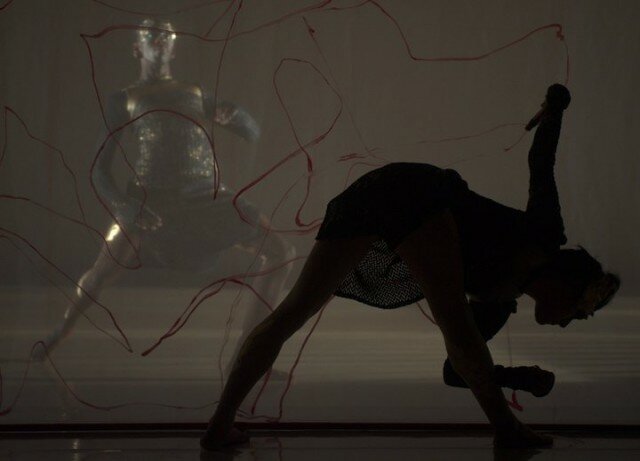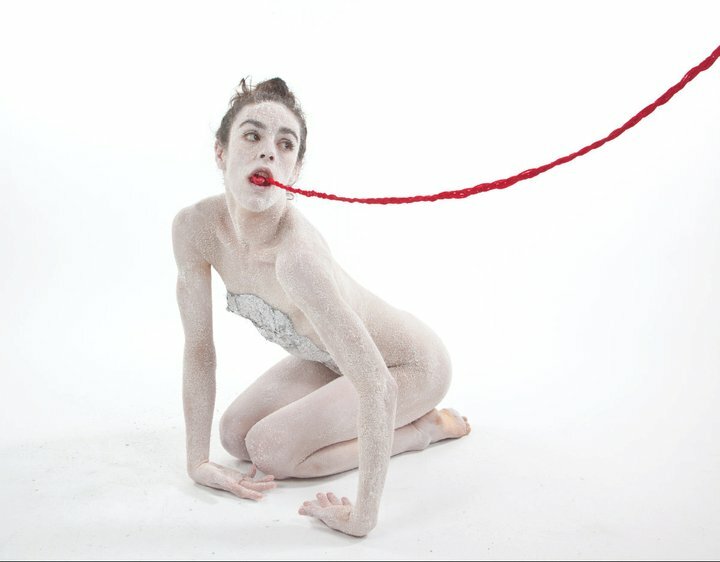
In September, The SunBreak’s arts editor-at-large, Jeremy M. Barker, was in Portland, Oregon for PICA’s TBA Festival, where he caught zoe | juniper’s A Crack In Everything, which opens this week at On the Boards (Dec. 1-4; tickets $20). The following originally appeared in a slightly different form as a review at Culturebot.org.
Nearly two weeks ago now, while sitting in the theater at Portland State University’s Lincoln Hall where zoe | juniper‘s A Crack in Everything was playing as part of the TBA Festival, I got to thinking about the idea of “eternal recurrence.” This was not actually the first time dance had inspired that. I’m not much of philosopher, though–my understanding of the concept mostly coming from Milan Kundera’s Unbearable Lightness of Being–so I probably can’t do it proper justice. But think of it as a thought experiment: Imagine that our lives–all of history, really–repeat an infinite number of times. Identically. Like the movie Groundhog’s Day, but without the opportunity to change or fix what you’ve done. You’re just stuck with it. So what does this do to each experience, however seemingly insignificant? Instead of passing by in the flash of the vanishing present, each experience takes on a weight and significance we wouldn’t normally grant it.
For such a seemingly cerebral concept, it’s something dance is–in my experience–much better at dealing with than literature or text-based performance. The intellectual in me wants to try to riff on how this all has something to do with verb tense, but at a pretty basic level, the issue has to do with immediacy. Text is never really the same as the experience it records–it’s a processing of experience through language, a record, almost a memory itself. Memory is a big topic in literature, but from this perspective, literature about memory is at a double remove from the thing itself; experience requires an immediacy you can’t get through text, which has already processed it.
Dance, though, gets to sort of have it both ways. On the one hand, you have the actual, physical presence of the dancer’s body, inhabiting the immediacy of experience in the moment you’re seeing it. On the other, through the choreography, construction, design, scenography, whatever, the experience can be contextualized, framed, examined within the larger work.
Anyway, the point is, I think this is as good a way as any to approach A Crack in Everything, a complex, provocative, and occasionally stunning dance-installation (the set itself rises to the latter definition, plus there is an actual attendant gallery piece which I did not see). Its central images all focus an unrelenting gaze on experiences, inhabited by the dancers, engaging them over and over again, in a sense chopping up the linear flow of time to demand we consider otherwise fleeting moments, without the comforting sfumato effect memory offers.
The work is the collaboration of choreographer Zoe Scofield, and her husband, visual artist Juniper Shuey. I’ve known them in some capacity for a couple years (they’re based in Seattle) but I haven’t actually seen too much of Scofield’s work. In fact, of the half-dozen (perhaps) times I’ve seen her perform previously, all but one were work-in-progress or rehearsal excerpts of this piece.
Scofield is a fine dancer and subtle, very physical choreographer, but the work makes dynamic use of Shuey’s design contributions in ways that add substantially to the effect. As it opens, a couple of the dancers emerge in darkness and begin to perform on a dimly lit stage. Spatially, they work a line across the downstage area, near what will turn out to be a milky glass wall running the width of the space. What we’re greeted with first is a series of ephemeral images, with counterpointing dancers being revealed by lighting behind (or perhaps projected on, or perhaps both–I couldn’t actually tell) the glass wall.
But the first truly impressive sequence comes next. As the stage explodes with light, the company of four (three women, one man) dancers ups the tempo of the piece considerably in the upstage area, while Scofield herself performs a long left-to-right solo across the glass, spinning and moving herself slowly, the whole while tracing (parts of) her silhouette in a red marker on the glass. It’s long and forceful, and what we’re ultimately left with is a beautiful image capturing the spirit of the piece. After this, the glass wall, perhaps six or eight feet tall, raises 3/4 of the way into the vertical space, framing the stage with an evocation of the central image of movement as experience and memory both.
My favorite part, though, comes a little bit later. The four female dancers essentially repeat Scofield’s solo from left to right as the lone male dancer, Raja Kelly, playing a sort of Spirit of Time, simply walks among them, picking them up and moving them back toward stage-left, where they pick up from that moment in space and continue moving right (forward) again. In other words, it’s a bit like rewinding a video over and over again to watch certain moments.
The effect is pretty overwhelming, because Scofield’s style is so formally intense. I’ve occasionally said that “no one moves quite like” Scofield (an artistic director I know described her movement as “feral,” to give you an image), but that’s not entirely true; rather, Scofield’s body has a unique quality that she maximizes the use of in her dance. Lean and muscular, her body exaggerates the slightest movement because it’s so visibly apparent on her. A shift of weight or balance, a twist of the torso, a rotation of the arm: you see all of them as big, dramatic gestures despite their subtlety. The challenge Scofield faced, as I saw it, was translating this distinctively style into her company. And I was pleasantly surprised by how well she pulled it off.
This long rewind/replay sequence called on the other dancers to match Scofield’s abilities more than, I think, any other part of A Crack in Everything. Their progress occurs in stutters, the process of getting between each tableau a set of highly articulated shifts, during which the dancers really have to paint those subtle changes with big strokes. Mostly they succeed. One dancer in particularly really owned it, but without a line-up I can’t be sure which (I think it’s Diana Deaver, a Brooklyn-based artist), but all of them were sufficiently up to the task that the effect carried.
The result was powerful, constantly refocusing the audience on these deeply emotionally resonant moments, forcing you to look at them over and over again. It was damn near breathtaking, and one of the more fascinating moments I’ve seen in a dance piece in a while.
